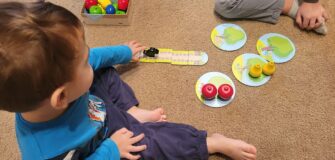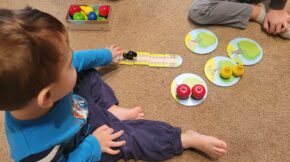11 Tips and Tricks to Encourage Crawling in Babies
Share

Are you looking for ways to help your baby crawl and master their moves? Witnessing your baby crawl for the first time is a feeling that can’t be expressed in words. It is important for babies to achieve this developmental milestone as they progress towards running and walking after it.
If you want to know how to help babies crawl and achieve their movement milestones, you can use various techniques like helping them sit upright and offering their favorite toys.
You can encourage your little ones to crawl by giving them sufficient tummy time and holding them in a crawling position. You should also limit the time your baby spends in high chairs, car seats, and walkers as they impede your baby’s physical development. Encourage your baby to move as much as they can so that they get ready to crawl at the right time.
You can place their favorite toy out of reach and encourage them to hurry toward it. It is also important to create a safe crawling environment so that your bundle of joy doesn’t get hurt during the crawling process.
Tips and Tricks to Stimulate Crawling in Babies
Let’s take a look at 11 tried and tested ways to encourage your baby to crawl and achieve their developmental milestone.
1. Crawl with Your Baby
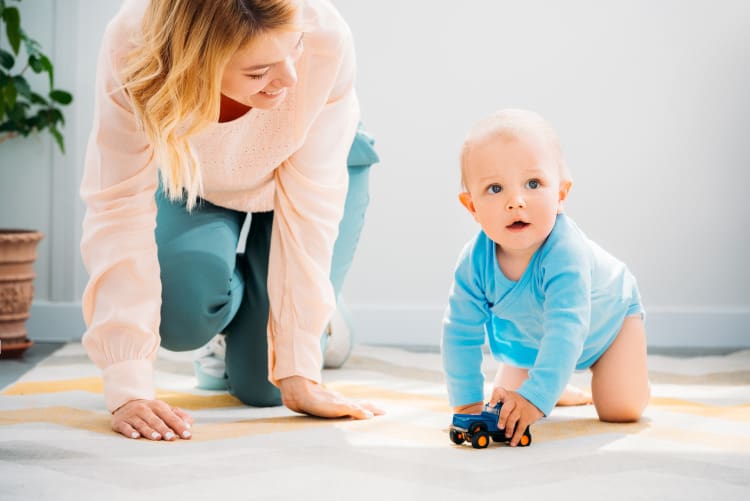
Babies imitate the adults around them and try to learn new things. If their father sticks out their tongue, the little one copies the same behavior. So while teaching your kids how to crawl, you can take advantage of your little one’s imitative nature.
While playing with your baby, sit on the floor and try to crawl, showing your little one how it is done. When you practice crawling with your baby on a daily basis, there are chances that they might end up imitating you.
You can also get together with other babies and moms for playtime to encourage crawling in your baby. When your little one sees other babies crawling, they will also try to imitate them, achieving their important milestones. But remember not to force your baby to crawl when you see other babies crawling. Rather, help them learn at their own pace.
2. Encourage Tummy Time

Do you know that tummy time is one of the best exercises for babies to develop their muscles and help them grow strong? Tummy time can also help your baby crawl as they learn to roll over and scoot on their belly during this process.
Experts suggest that the more time your baby spends on their tummy earlier, they start crawling. Tummy time can strengthen your baby’s neck, legs, back, and arms and help them experience different movements and body positions.
If your baby doesn’t like tummy time, you can place a sensory blanket or water mat underneath them to help them stay entertained. Your baby should practice tummy time only when they are awake under the supervision of an adult.
3. Encourage Your Little One to Play with Their Hands Elevated
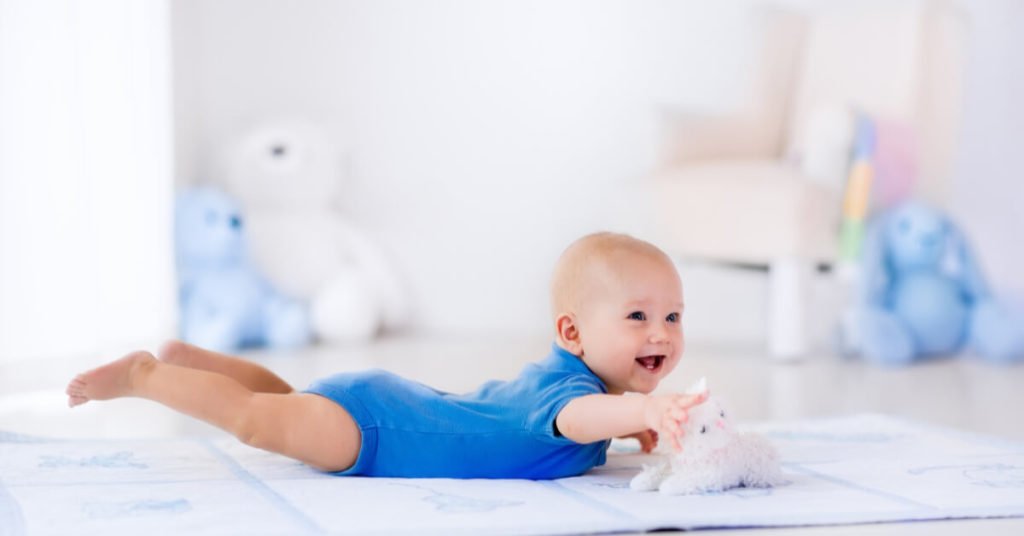
If you’re wondering how to help babies crawl, then encouraging them to play with their hands elevated can be a good idea. Initially, your baby may not be able to elevate their hands, but slowly and gradually, they will be able to do this.
To encourage your kid to elevate their hands while playing, put their arms on the top of a stuffed animal or pillow during tummy time. Another idea can be to sit your baby close to sturdy furniture and encourage them to pull themselves up while elevating their hands.
The furniture should be sturdy else your little one may fall over and get hurt. You can also place toys above your baby’s head so that they elevate their hand to grab the toy. This will help them build the strength they need to crawl and stand when they grow older.
4. Place Objects Out of Reach
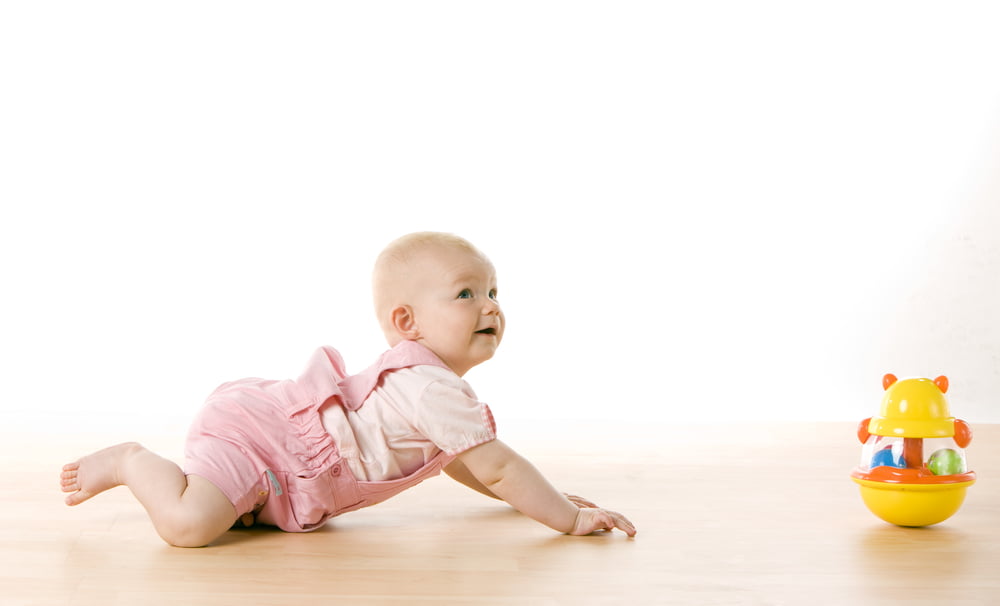
Another way to encourage your baby to crawl is by placing their favorite toys or bright objects out of reach. Kids have a natural tendency to approach things they find interesting.
When placing the toys around your baby, ensure that they are not too far away from your baby, or else they won’t try to grab them. You can put your little one on the floor or in the sitting position and set toys slightly to their right or left.
While trying to grab the toy, they will lift their back and chest and try to move around, thereby helping them crawl. You can also make your baby sit upright on the floor and move a toy in front of them to encourage them to follow the toy with their eyes and grasp it.
Ensure that the toys you place around your kids don’t have sharp edges, or else they might get hurt badly. You can use simple toys like rattles and stretch and pull bounce balls to encourage holding and touching.
5. Limit the Use of Supportive Devices
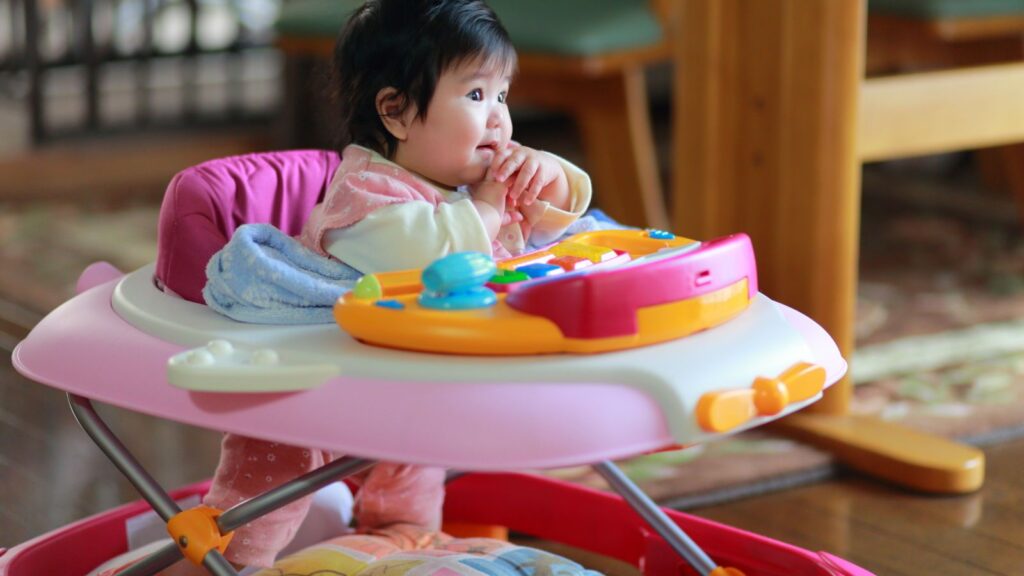
Do you know that one of the reasons for your little one’s delayed development can be the excessive use of supportive devices? The market is full of supportive devices like walkers and high chairs that claim to make your kid’s walking and crawling journey easier.
But if you believe the experts, supportive devices do more harm than good when it comes to your baby’s overall development. They impede the muscular development of your baby as the kids get dependent on them to get much-needed support.
In turn, they don’t use their muscles to support or balance their weight leading to delayed walking. So limit high seats, strollers, walkers, and car seats as much as possible in your kid’s life. Use them only when it is unavoidable, like while going out in the park with your kid or in the airport where you have to travel a lot.
6. Put the Child in Front of a Mirror
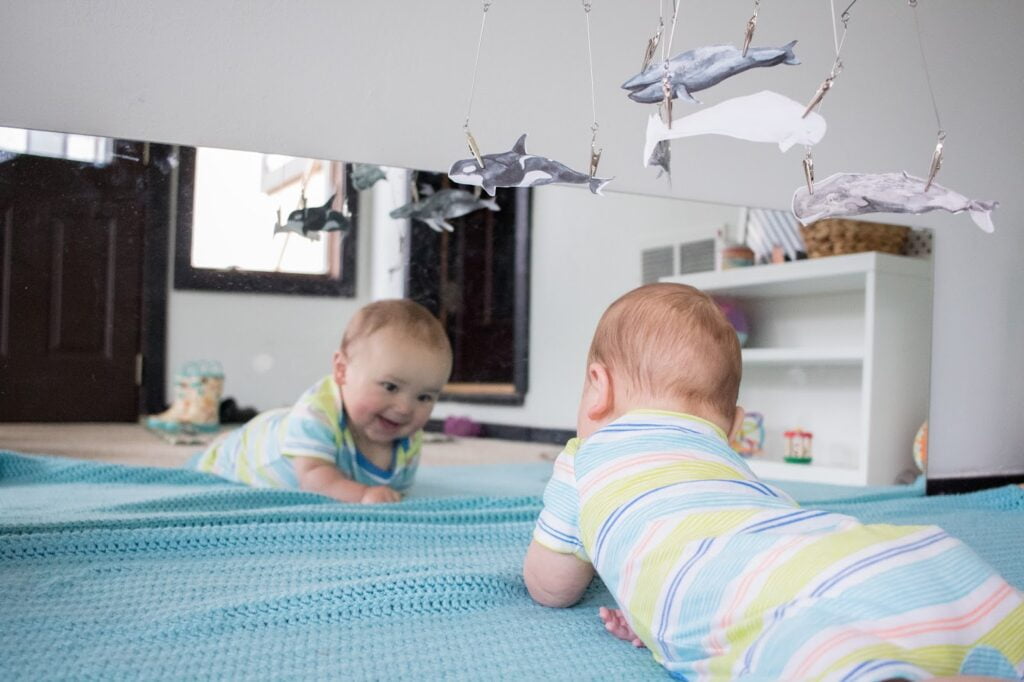
For all those parents confused about how to help their baby crawl, allowing their little ones to play in front of the mirror can be a brilliant idea. Babies are naturally curious, and when they see their reflection in the mirror while playing, they will try to make a movement forward. This way, they will put in some effort to reach out toward the mirror to touch the reflection that moves along with them.
During this process, they will learn to hold themselves up to see the action of their reflection. These movements will strengthen your baby’s muscles and bones and help them crawl in no time! This activity should be carried out under supervision, and the area around the mirror should be hazard-free to ensure your kid’s safety.
7. Help Your Baby Get a Leg Workout
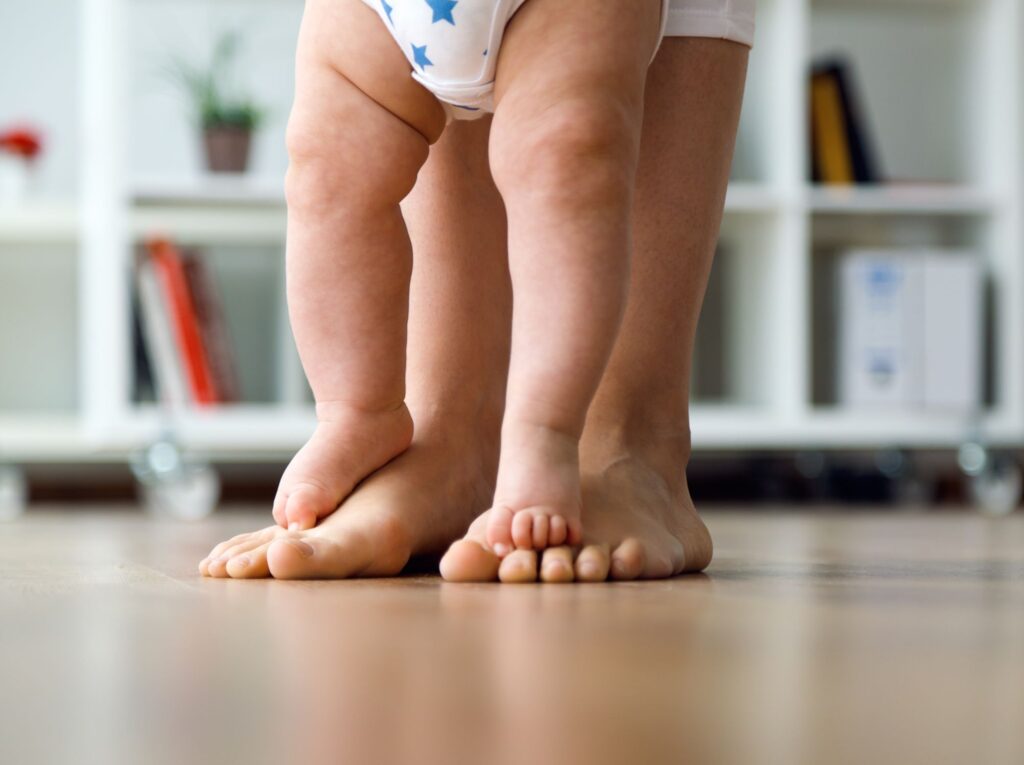
Your baby’s muscles should be strong enough to sit up, roll over, hold up their head, and crawl. You may think that they exercise their little muscles a lot during a diaper change or while batting at an object, but you’re wrong.
You should indulge your little one in at least thirty minutes of physical activity to ensure that their muscles become strong and they reach their development milestones on time.
You can lift your little one off the floor a bit and keep them in the same position for a few minutes to strengthen their pint-sized muscles. Pick your baby up by the armpits or arms to support their body weight.
This will allow your wonder of joy to practice the motion of walking and crawling. This can also be a relaxing physical activity for parents looking for how to help their baby crawl.
8. Create a Simple Obstacle Course
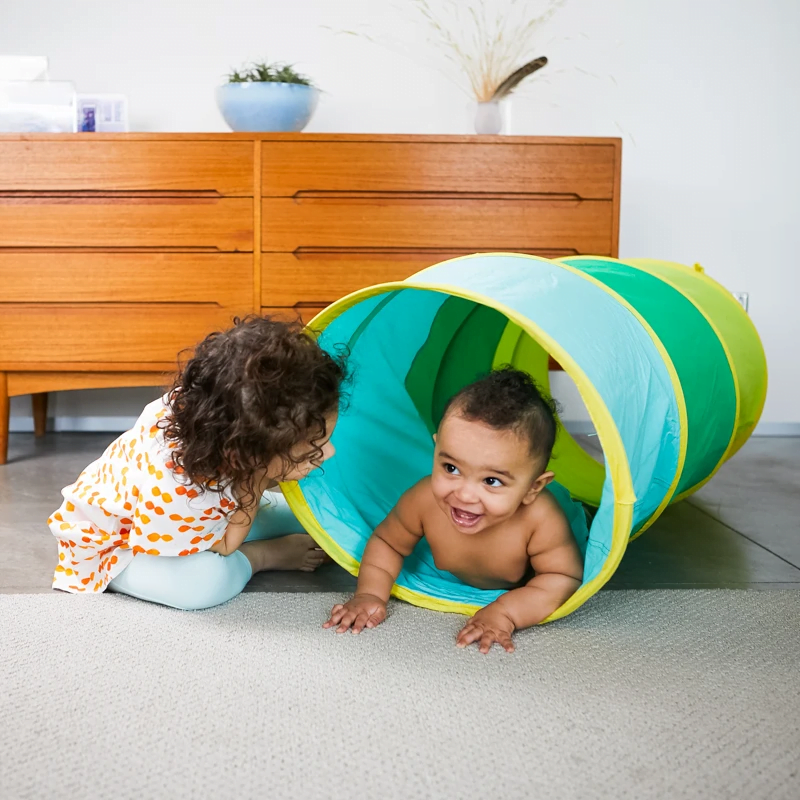
If you want to get your baby crawling earlier, you can create a simple obstacle course and encourage them to pass through it. A crawl tunnel can help improve your little one’s flexibility and joint mobility.
Get your kid excited about crawling through a tunnel by decorating it with streamers and colorful ribbons. You can also put some rewards like toys, books, or colorful balls at the end or middle of the tunnel to motivate your kid to crawl through it.
Start with a short tunnel and increase the length gradually as your little one becomes comfortable crawling through the play tunnel.
You can buy a play tunnel from your nearby kid’s store or even create it at your home by putting a blanket over kitchen chairs. If you’re making a crawl tunnel at your home, it should be at least two feet above the ground to give the illusion of a real tunnel.
9. Bicycle Your Baby’s Legs
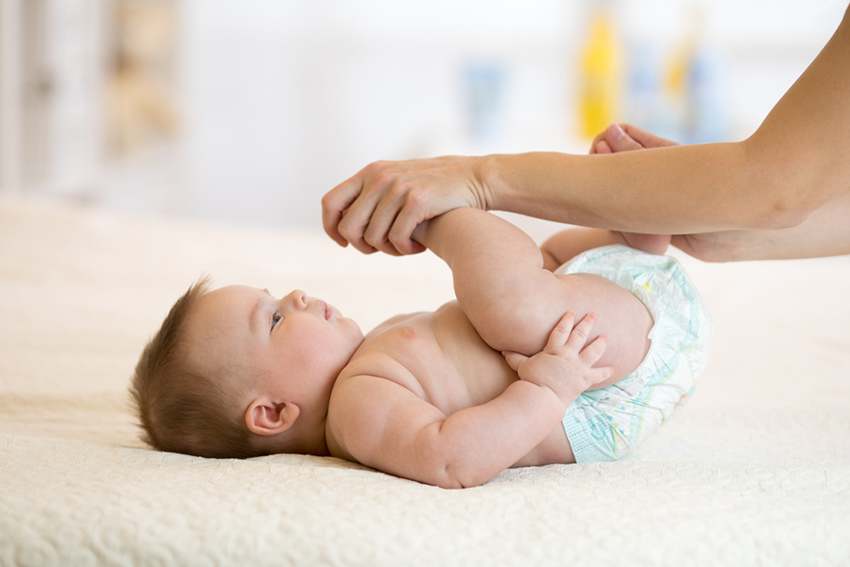
Bicycling your baby’s legs is not only the best way to relieve your baby’s gas but also encourages them to crawl. Many parents use this way to push air out of their baby’s system if the little one is feeling bloated.
However, the same method can be used to encourage your baby to crawl and move. Bicycling is an excellent workout for your baby’s abs, hips, legs, and knees and increases their flexibility. You can put your little one on their back and move their legs around and up as if they are pedaling a bicycle.
To encourage them, you can sing, coo, smile, or make noises. Repeat the movement seven to eight times daily to strengthen your baby’s leg muscles. As you practice this activity with your kid, they will bond with you, have a fun workout, and learn to move forward and backward.
10. Let Your Baby Play on All Sides

Playtime is important for all areas of development of your little one. Your child giggles with joy when you play with them and learns to do new things when you make them use their body parts through different play ideas.
To encourage movement and crawling, you should try different play activities with your kids. You can sing rhymes and songs to encourage your baby to move to sound and music.
During playtime, allow your baby to move into different positions and let them play on all sides. There should be an even mix of left side, right side, tummy, and back to help your baby’s body become healthy and strong. Encourage your little one to squat from standing by placing toys or colorful books on the ground in front of them so they try to squat to pick them up.
11. Help them Build Resilience

Your kids need your support and guidance to come out of difficult events and try out new experiences. While teaching your kids to crawl, they may fall at times, but during those times, you must react appropriately.
Don’t overreact or show too much concern, as it may restrict your child from trying the same activity again. Remember, when your baby falls, your facial expressions, body tone, and language are crucial.
Don’t yell at your child as they may get scared and stop trying a new thing which can adversely affect their growth and development in the long run.
When things go wrong, kids look up to parents for their reaction, so you must handle the situation with empathy and compassion.
If your child falls while crawling, pat them gently and encourage them to crawl again. This will instill confidence in them that nothing wrong has happened, and they can try the activity again.
Things to Keep in Mind While Encouraging Your Baby to Crawl
- Be patient when teaching your kids to crawl to ensure that they have positive associations with the activity. If they are not enjoying it or start crying during playtime, you can call off the activity and try it any other time.
- When your little one begins to crawl, they will want to move about all day. Provide enough space so that they can practice their newly acquired skill freely.
- Ensure that your little one is wearing the right kind of clothing when they begin to crawl. Crawling children may collide with various things lying around the house and fall. That’s why they need protective baby headgear to protect them from bruises, scrapes, and head bumps.
- Try to include toys that excite your kids and encourage them to crawl.
- When your baby has learned the traditional crawling style, place your palms behind their feet and assist them to move forward.
- Remove pointed objects from your house when your baby starts crawling, as your little one may get hurt while exploring their newly found skill.
Conclusion
Crawling is an important milestone that all parents want their kids to achieve at the right age. It is the first attempt of the baby to move around independently, but many kids may show signs of delayed growth, leading to stress among the parents.
This may make the parents wonder how to help the baby crawl if their little ones have reached a certain stage and still haven’t started crawling.
You can try out various activities with your kids, like tummy time, bicycling, and leg workouts to encourage them to crawl. You can try out the ideas mentioned above to help your bundle of joy reach its crawling milestone.
And still, if your baby doesn’t crawl, worry not, as few babies may skip the crawling milestone and go straight to standing and walking.
Frequently Asked Questions
When Do Babies Start Crawling?
All babies are different, so there is no set timeline for babies to start crawling. Some babies start crawling early, while others take time to crawl and move. It is also important to note that a few babies may skip the crawling milestone and go straight to standing and walking.
What are the Different Crawling Styles of Babies?
The most common baby crawling style is moving around on their knees and hands. A few other ways babies crawl include classic crawl, backward crawl, commando crawl, scoot crawl, and crab crawl. Your baby can start their crawling journey with any of these crawling styles, or they can even skip crawling altogether and start walking.









